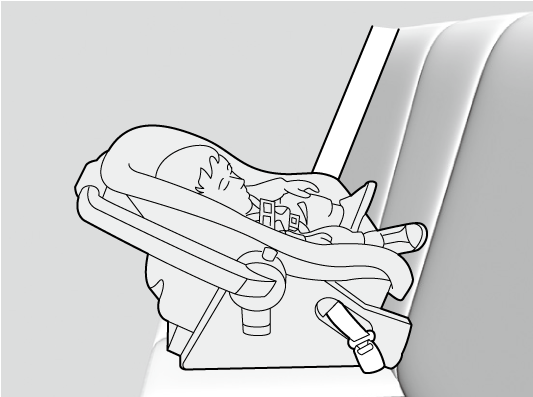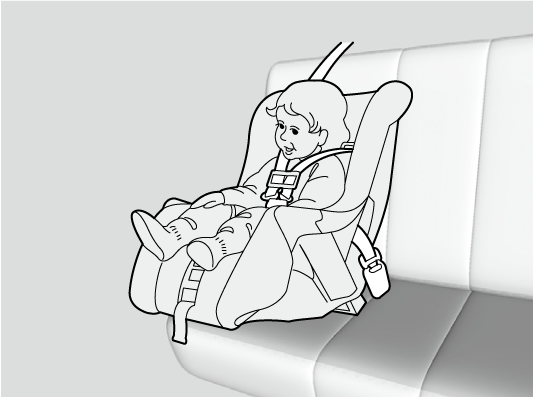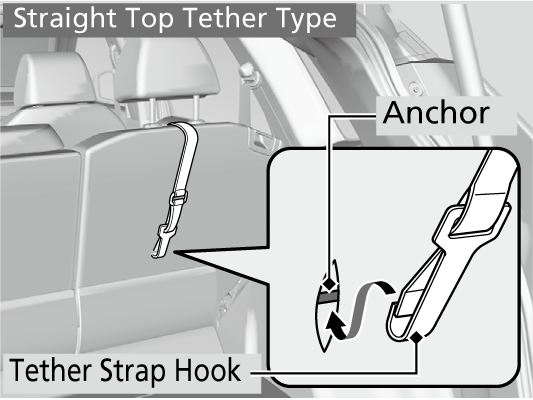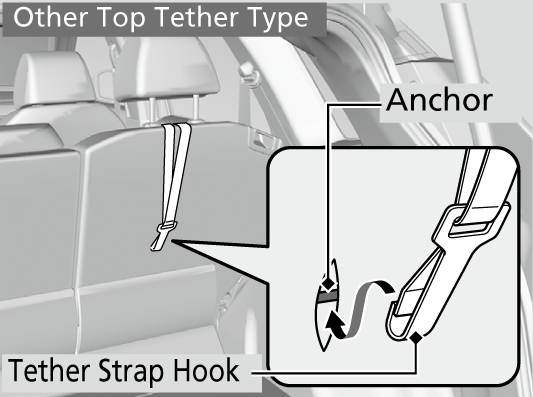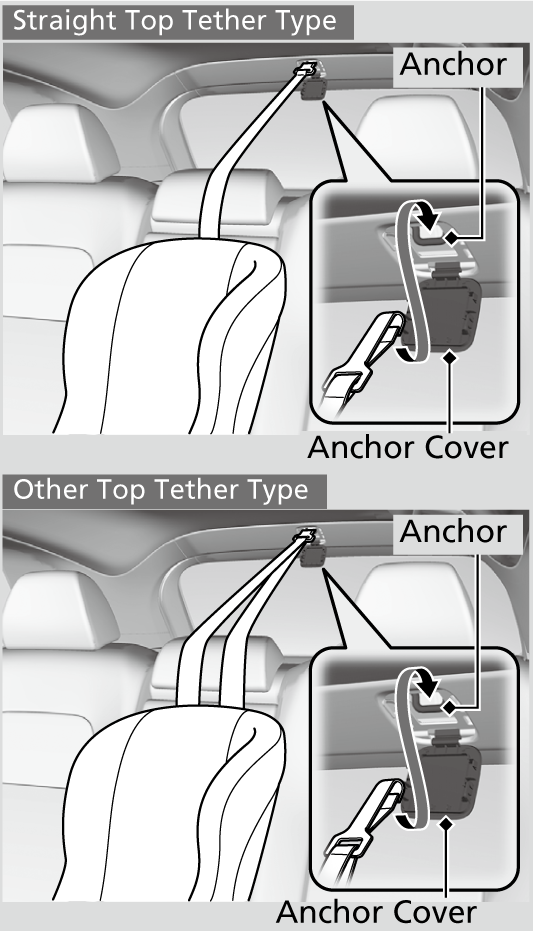Safety of Infants and Small Children
Protecting Infants
An infant must be properly restrained in a rear-facing child seat until the infant reaches the seat manufacturer’s weight or height limit for the seat.
When properly installed, a rear-facing child seat may prevent the driver or a front passenger from moving their seat all the way back, or from locking their seat-back in the desired position. Make sure that there is no contact between the child seat and the seat in front of it.
It can also interfere with proper operation of the passenger's advanced front airbag system.
Airbag System ComponentsTypes of AirbagsFront Airbags (SRS)Knee AirbagsSide AirbagsSide Curtain AirbagsAirbag System IndicatorsAirbag Care
If this occurs, we recommend that you install the child seat directly behind the front passenger's seat, move the seat as far forward as needed, and leave it unoccupied. Or, you may wish to get a smaller rear-facing child seat.
- WARNING
-
Placing a rear-facing child seat in the front seat can result in serious injury or death during a crash.
Always place a rear-facing child seat in the rear seat, not the front.
- Detail
-
Experts recommend use of a rear-facing seat for a child so long as the child’s height and weight are appropriate for a rear-facing seat.Infants should never be seated in a forward-facing position.Always refer to the child seat manufacturer's instructions before installation.Do not allow a front seat to rest against a child seat installed in a rear seating position.
The weight sensor in the front seat may not correctly detect the actual weight of the occupant.
Protecting Smaller Children
If a child has exceeded the weight and height limitations of a rear-facing child seat, the child should be properly restrained in a firmly secured forward-facing child seat until they exceed the weight and height limitations for the forward-facing child seat.
Placing a forward-facing child seat in the front seat can be hazardous, even with advanced front airbags that automatically turn the passenger's front airbag off. A rear seat is the safest place for a child.
- WARNING
-
Placing a forward-facing child seat in the front seat can result in serious injury or death if the front airbag inflates.
If you must place a forward-facing child seat in front, move the vehicle seat as far back as possible, and properly restrain the child.
- Detail
-
Educate yourself about the laws and regulations regarding child seat use where you are driving, and follow the child seat manufacturer's instructions.
Selecting a Child Seat
Most child seats are LATCH-compatible (Lower Anchors and Tethers for Children). Some have a rigid-type connector while others have a flexible-type connector. Both are equally easy to use. Some existing and previously owned child seats can only be installed using the seat belt. Whichever type you choose, follow the child seat manufacturer's use and care instructions including recommended expiration dates as well as the instructions in this manual. Proper installation is key to maximizing your child's safety.
In seating positions and vehicles not equipped with LATCH, a LATCH-compatible child seat can be installed using the seat belt and a top tether for added security. This is because all child seats are required to be designed so that they can be secured with a lap belt or the lap part of a lap/shoulder belt. In addition, the child seat manufacturer may advise that a seat belt be used to attach a LATCH-compatible seat once a child reaches a specified weight. Please read the child seat owner’s manual for proper installation instructions.
- Detail
-
Installation of a LATCH-compatible child seat is simple.LATCH-compatible child seats have been developed to simplify the installation process and reduce the likelihood of injuries caused by incorrect installation.
Important consideration when selecting a child seat
Make sure the child seat meets the following three requirements:
- The child seat is the correct type and size for the child.
- The child seat is the correct type for the seating position.
- The child seat is compliant with Federal Motor Vehicle Safety Standard 213 or Canadian Motor Vehicle Safety Standard 213.
Installing a LATCH-Compatible Child Seat
A LATCH-compatible child seat can be installed in either of the two outer rear seats. A child seat is attached to the lower anchors with either the rigid or flexible type of connectors.
-
The location of each lower anchor is shown in the illustration.
- Make sure to lock the seat-back in the upright position.
-
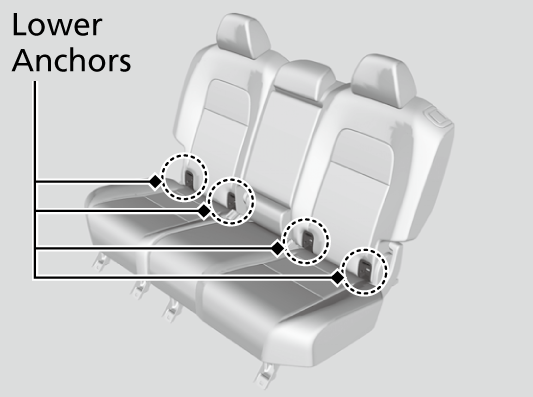
-
- Place the child seat on the vehicle seat, then attach the child seat to the lower anchors according to the instructions that came with the child seat.
- When installing the child seat, make sure that the lower anchors are not obstructed by the seat belt or any other object.
- Place the child seat on the vehicle seat, then attach the child seat to the lower anchors according to the instructions that came with the child seat.
-
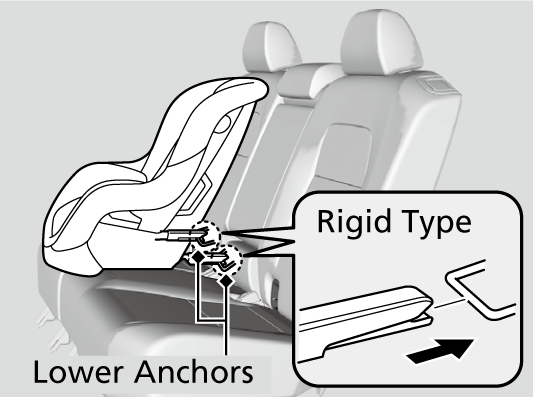
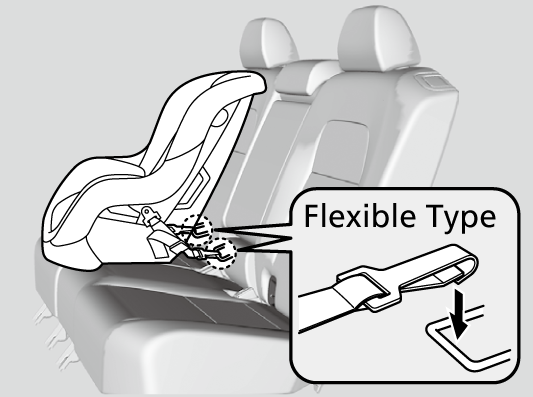
-
- Raise the head restraint to its highest position, then route the tether strap through the head restraint legs.Make sure the strap is not twisted.
- Secure the tether strap hook to the anchor.
- Tighten the tether strap as instructed by the child seat manufacturer.
- Make sure the child seat is firmly secured by rocking it forward and back and side to side; little movement should be felt.
- Make sure any unused seat belt that a child can reach is buckled, the lockable retractor is activated, and the belt is fully retracted and locked.
-
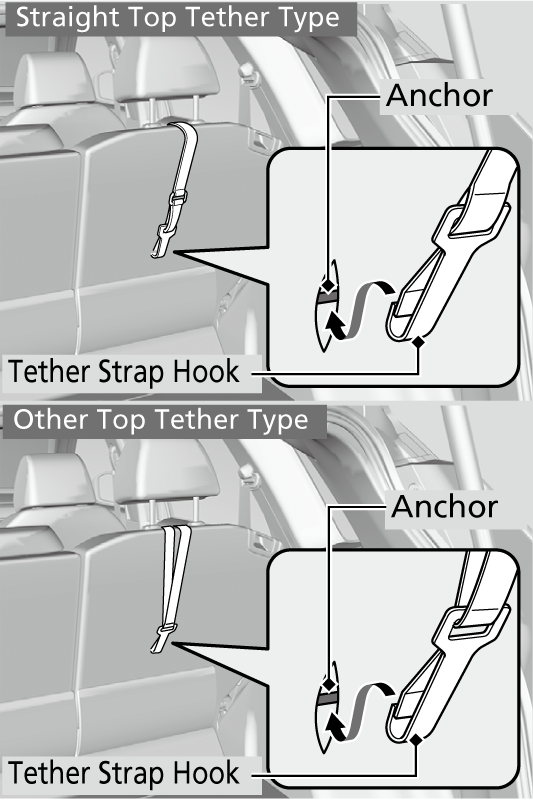
- WARNING
-
Never attach two child seats to the same anchor. In a collision, one anchor may not be strong enough to hold two child seat attachments and may break, causing serious injury or death.
- WARNING
-
Using the outer rear seats’ inner anchors to secure a LATCH-compatible child seat in the center seating position may result in failure of the child seat, causing injury or death.
Only use the outer rear seats’ inner anchors to install a child seat in the center seating position if the manufacturer’s instructions expressly permit.
- Detail
-
For your child’s safety, when using a child seat installed using the LATCH system, make sure that the child seat is properly secured to the vehicle. A child seat that is not properly secured will not adequately protect a child in a crash and may cause injury to the child or other vehicle occupants.Installing a LATCH-compatible child seat in the rear center seatEach outer rear seat is equipped with a pair of lower anchors which are used to secure a LATCH-compatible child seat. The rear center seat, however, is not equipped with anchors of any kind.
The inner and outer anchors are spaced apart at a standard distance of 11 inches (280 mm). The distance between the two inner anchors is 17 inches (432.6 mm).
LATCH-compatible restraint systems that are fitted with rigid-type attachments cannot be installed in the rear center seat. However, a system fitted with flexible-type attachments can be installed in the center seat, provided that the manufacturer’s instructions for that system permit the use of the inner anchors with the stated spacing.
Before seating a child, make sure that the system is properly attached to both the lower anchors and tether anchors.
Installing a Child Seat with a Lap/Shoulder Seat Belt
A child seat can be installed with a lap/shoulder belt in any rear seat or, if absolutely necessary, the front passenger seat.
-
- Make sure to lock the seat-back in the upright position.
- Place the child seat on the vehicle seat.
- Route the seat belt through the child seat according to the seat manufacturer’s instructions, and insert the latch plate into the buckle.
- Insert the latch plate fully until it clicks.
-
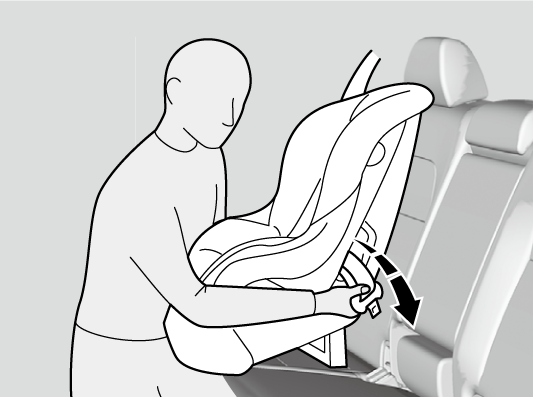
-
- Slowly pull the shoulder part of the belt all the way out until it stops. This activates the lockable retractor.
- Let the seat belt retract a few inches and check that the retractor has switched modes by pulling on the webbing. It should not pull out again until it is reset by removing the latch plate from the buckle.
- If you are able to pull the shoulder belt out, the lockable retractor is not activated. Slowly pull the seat belt all the way out, and repeat steps 4 – 5.
-
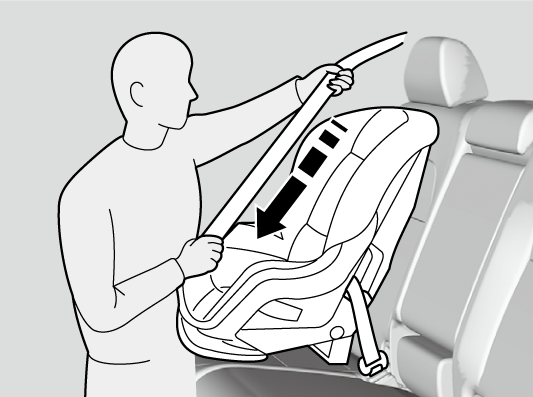
-
- Grab the shoulder part of the seat belt near the buckle, and pull up to remove any slack from the lap part of the belt.
- When doing this, place your weight on the child seat and push it into the vehicle seat.
- Grab the shoulder part of the seat belt near the buckle, and pull up to remove any slack from the lap part of the belt.
-
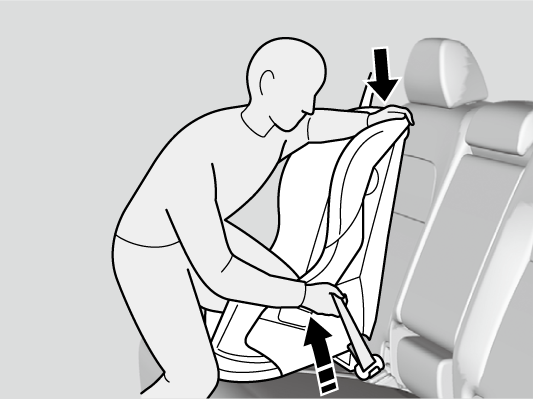
-
- Make sure the child seat is firmly secured by rocking it forward and back and side to side; less than one inch of movement should occur near the seat belt.
- Make sure any unused seat belt that a child can reach is buckled, the lockable retractor is activated, and the belt is fully retracted and locked.
-
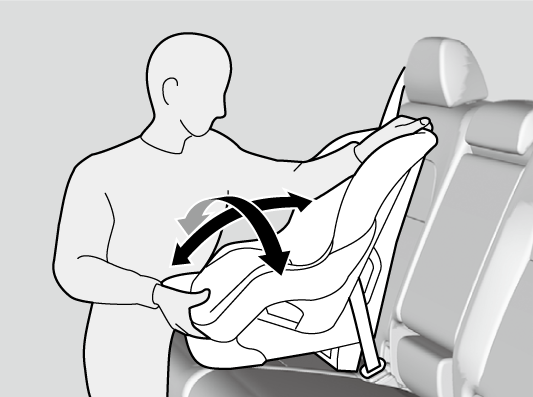
- Detail
-
A child seat that is not properly secured will not adequately protect a child in a crash and may cause injury to the child or other vehicle occupants.To deactivate a lockable retractor, release the buckle and allow the seat belt to wind up all the way.
Adding Security with a Tether
-
A tether anchor point is provided behind the rear outer seating positions and in the ceiling for the rear center.
If you have a child seat that comes with a tether but can be installed with a seat belt, the tether may be used for additional security.
-
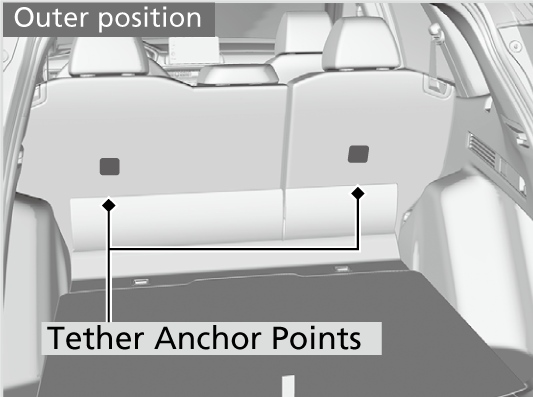
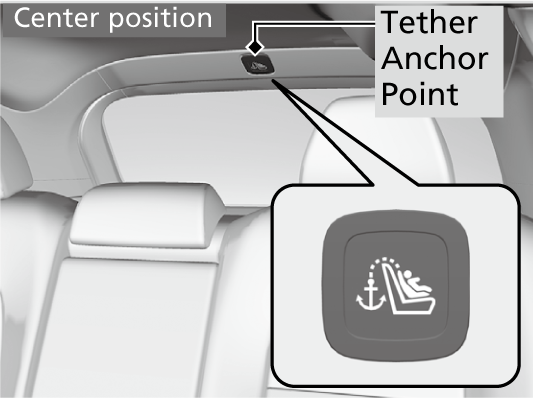
- Detail
-
Always use a tether for forward-facing child seats whether using the seat belt or lower anchors.
- Recommended topic(s)

